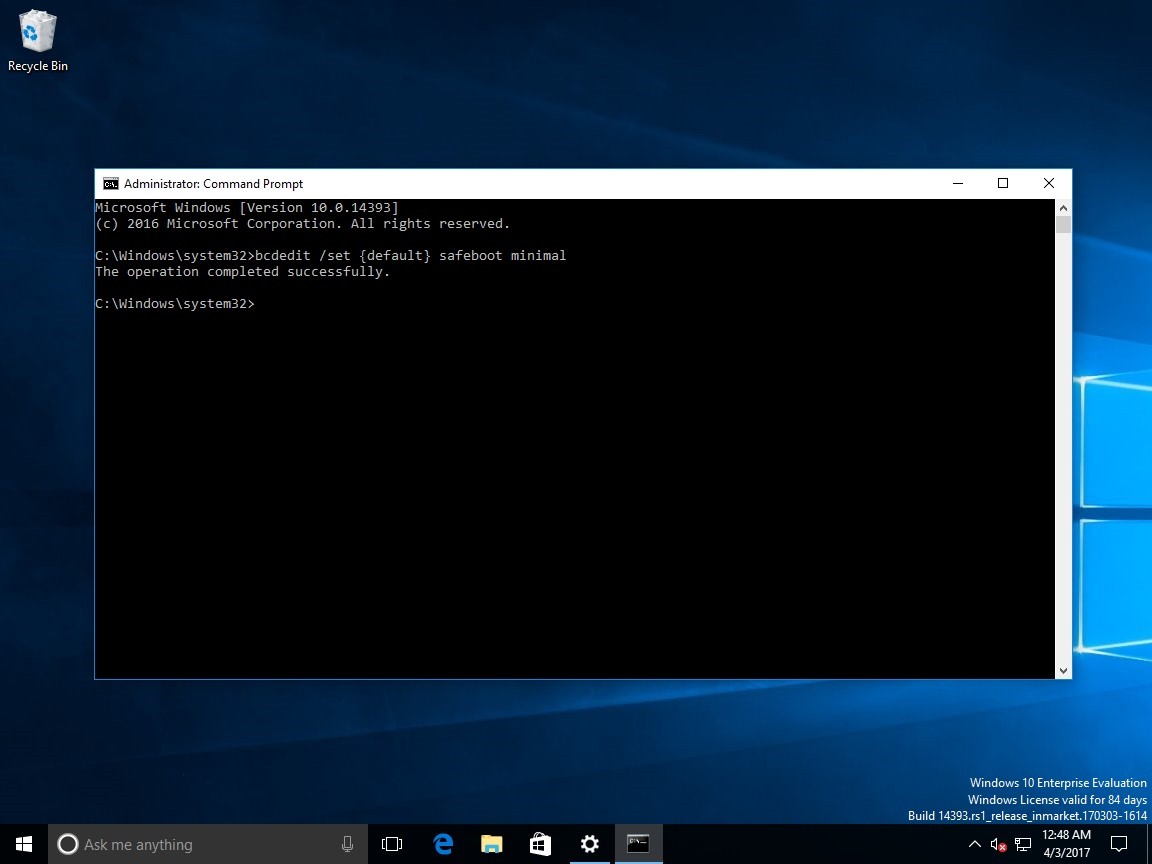
:max_bytes(150000):strip_icc()/D1-BootinSafeModeonWindows10-annotated-8a044a5954e94c4e8bccec8d4bbaba43.jpg)

- BOOT TO SAFE MODE WINDOWS 10 UPDATE
- BOOT TO SAFE MODE WINDOWS 10 WINDOWS 10
- BOOT TO SAFE MODE WINDOWS 10 PC
- BOOT TO SAFE MODE WINDOWS 10 WINDOWS 8
If you’re unable to even boot to the desktop to use either Method 1 or Method 2, this might be your best bet.
BOOT TO SAFE MODE WINDOWS 10 WINDOWS 10
Note that this method will bypass the Windows 10 ‘Choose an option’ screen detailed in Method 1 and go straight to Safe Mode. Doing so later will allow you to use your system as usual and then boot into Safe Mode the next time you restart. You’ll now be asked if you want to restart now or later. More often than not, the Minimal option will be what you want to boot into for most fixes. Active Directory Repair will boot Safe Mode with File Explorer open and critical system services. If you select Alternate Shell you’ll boot into Safe Mode with a Command Prompt running only critical system services and no networking. Select the Network radio button if you want network access while in Safe Mode. Now check the option that’s marked Safe boot. Then type in ‘msconfig’ (without the quotes) and hit enter. Navigate to the Boot tab at the top. To get to this from the Windows 10 desktop, hit Win+R on your keyboard to bring up the Run menu.

To select your option, press the corresponding number key on your keyboard and the system will reboot in the applicable Safe Mode.Īnother option is to use the System Configuration menu. Unless you know that you need a specific option, the first one, ‘Enable Safe Mode’, will be the right option for most people. You’ll want to use options 4-6 depending on what level of Safe Mode you require. Hit the Restart button to reboot your system.Īfter a reboot you’ll get a list of nine options. You’ll be presented with a screen telling you what settings can be changed after a restart. Now from this screen select Advanced Options. Select the Startup Settings option, which should be the final option. Now select the Troubleshoot option at the bottom. Your system will now reboot into the Windows 10 recovery menu. After rebooting you’ll be presented with the ‘Choose an option’ screen. Hold down Shift on your keyboard and select the Restart option. First bring up Windows 10’s Start Menu and click the Power option. If your system is generally working fine and you are able to boot into the desktop, this will be by far the easiest way to get to Safe Mode. We go through a few different ways to access Safe Mode without breaking too much of a sweat. Windows 10, however, boots up so much faster that this is no longer a reliable method (although it might still work if you’re lucky and persistent). The process for doing so hasn’t changed drastically from previous versions of Windows but, due to just how much faster the operating system can boot up, it might require you to try different methods depending on your system and the current state of your operating system.Īt this point, you might be thinking that hitting F8 or Shift+F8 after your computer turns on, as in the past, will get you to the Safe Mode options. It is, however, not without its problems, some of which will require you to boot into Safe Mode to help alleviate or fix them.
BOOT TO SAFE MODE WINDOWS 10 WINDOWS 8
Under Book options, clear the Safe boot checkbox.Windows 10 is a great operating system and it’s a great way to breathe new life into older systems thanks to free upgrades for Windows 7 and Windows 8 users. Type msconfig in the Open box and then select OK. When you're done, exit safe mode by restarting your PC. On the Windows sign-in screen, press and hold the Shift key while you select Power > Restart. Get to safe mode from the Windows sign-in screen:
BOOT TO SAFE MODE WINDOWS 10 PC
You may be asked to enter your BitLocker recovery key.Īfter your PC restarts again, select the startup setting you want to use. Under Advanced startup, select Restart now.Īfter your PC restarts to the Choose an option screen, select Troubleshoot > Advanced options > Startup Settings > Restart.
BOOT TO SAFE MODE WINDOWS 10 UPDATE
To open the settings manually, select Start > Settings > Update & Security > Recovery. Safe mode is a startup setting that can help you troubleshoot problems on your PC.


 0 kommentar(er)
0 kommentar(er)
